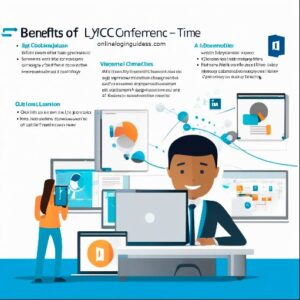LyncConf: Your Ultimate Guide to Microsoft Lync Conferencing Solutions
Introduction In today’s fast-paced, digitally connected world, effective communication is vital for organizational success. As remote work and virtual

Introduction
In today’s fast-paced, digitally connected world, effective communication is vital for organizational success. As remote work and virtual collaboration become the norm, businesses need reliable tools to streamline their communication processes. Enter Microsoft LyncConf, now part of Microsoft Teams a powerful conferencing solution designed to enhance teamwork, productivity, and connectivity across distances.
LyncConf serves as your comprehensive resource for mastering Microsoft Lync’s conferencing capabilities. This guide will cover everything you need to know, from basic features to advanced functionalities, helping you unlock the full potential of Lync for your meetings and collaborative efforts.

Why Choose LyncConf?
Microsoft Lync offers a rich suite of features that make virtual meetings not only possible but effective and engaging. With high-quality audio and video, intuitive screen sharing, and seamless integration with other Microsoft applications, Lync empowers teams to connect like never before.
In this guide, we’ll explore:
- Core Features: Understand the essential tools Lync provides for effective conferencing.
- Benefits: Discover how using Lync can save costs, enhance collaboration, and boost productivity.
- Setup Instructions: Step-by-step guidance on getting started with Lync.
- Best Practices: Learn strategies for conducting successful meetings.
- Troubleshooting Tips: Resolve common issues quickly to ensure smooth meetings.
By the end of this guide, you will be equipped with the knowledge and tools necessary to leverage Microsoft Lync for your conferencing needs. Embrace the future of communication and transform your team dynamics with LyncConf, your ultimate guide to Microsoft Lync conferencing solutions.
What is LyncConf?
LyncConf is a dedicated resource and guide focused on Microsoft Lync, a powerful communication and conferencing tool now integrated into Microsoft Teams. This platform facilitates seamless virtual collaboration, enabling users to conduct online meetings, video conferences, and real-time chats. LyncConf aims to demystify the capabilities of Microsoft Lync, providing users with essential information, tips, and best practices to maximize their conferencing experience.

Key Features of LyncConf
- Comprehensive Guides: LyncConf offers in-depth tutorials and step-by-step instructions on how to use Microsoft Lync effectively, covering everything from basic setup to advanced features.
- Best Practices: Users can access curated strategies for conducting efficient and engaging meetings, ensuring productive collaboration among team members.
- Troubleshooting Resources: LyncConf provides solutions to common issues, empowering users to resolve problems quickly and maintain smooth communication.
- Feature Highlights: The platform highlights essential functionalities of Lync, such as audio and video conferencing, screen sharing, and integration with Microsoft Office applications.
- User-Centric Approach: With a focus on user experience, LyncConf aims to make Microsoft Lync accessible to everyone, regardless of their technical proficiency.
Why Is LyncConf Important?
As remote work becomes increasingly prevalent, effective communication tools like Microsoft Lync are essential for maintaining team cohesion and productivity. LyncConf serves as an invaluable resource for businesses and individuals seeking to leverage Lync’s features to enhance their communication strategies.
By providing clear, actionable information and resources, LyncConf helps users navigate the complexities of virtual meetings, ultimately improving collaboration and driving success in today’s digital landscape. Whether you’re a newcomer or a seasoned user, LyncConf is your go-to guide for mastering Microsoft Lync conferencing solutions.
Key Features of Microsoft Lync Conferencing
1. High-Quality Audio and Video
Experience crystal-clear audio and HD video quality during meetings, ensuring that every participant can communicate effectively without distractions.
2. Screen Sharing Capabilities
Easily share your screen with participants to demonstrate presentations, collaborate on documents, or provide visual aids, enhancing engagement and understanding.
3. Instant Messaging Integration
Communicate in real-time using instant messaging, allowing quick exchanges of ideas and information without interrupting the flow of the meeting.
4. Recording and Playback
Capture important meetings with the recording feature, allowing team members to review discussions at their convenience and ensuring that no key details are missed.

Benefits of Using Microsoft Lync Conferencing Solutions
Microsoft Lync, now integrated into Microsoft Teams, offers a robust suite of conferencing solutions that cater to the needs of modern businesses. Here are some of the key benefits of using Microsoft Lync for your conferencing needs:
1. Enhanced Collaboration
Lync facilitates seamless communication among team members, regardless of their geographical locations. Features like screen sharing, video conferencing, and instant messaging enable real-time collaboration, fostering a more connected work environment.
2. Cost Efficiency
By utilizing Lync for virtual meetings, organizations can significantly reduce travel costs associated with in-person gatherings. This cost-effective solution allows teams to collaborate without the need for transportation or accommodation expenses.
3. Increased Productivity
Lync streamlines communication, allowing teams to focus on discussions rather than technical issues. With integrated tools for scheduling, file sharing, and task management, meetings can be conducted more efficiently, leading to quicker decision-making and enhanced productivity.
4. Flexibility and Accessibility
Microsoft Lync is accessible on various devices, including desktops, tablets, and smartphones. This flexibility allows team members to join meetings from anywhere, accommodating diverse work schedules and ensuring that everyone can participate, regardless of their location.
5. High-Quality Audio and Video
Lync provides high-definition audio and video capabilities, ensuring that meetings are clear and engaging. This quality enhances communication, making it easier for participants to understand and engage with one another.
6. Integration with Microsoft Office
As part of the Microsoft ecosystem, Lync seamlessly integrates with other Office applications like Outlook, Word, and Excel. This integration allows users to schedule meetings directly from their calendars, share documents effortlessly, and collaborate in real-time without switching between different platforms.
7. Recording and Playback Features
Lync enables users to record meetings, capturing important discussions and decisions. This feature is invaluable for team members who may have missed the meeting or need to revisit key points for clarity.
8. Security and Compliance
Microsoft Lync includes robust security features, such as encryption and multi-factor authentication, ensuring that communications are secure and compliant with industry standards. This is especially important for organizations handling sensitive information.
9. User-Friendly Interface
Lync’s intuitive design makes it easy for users of all technical backgrounds to navigate. With straightforward controls for initiating meetings, managing participants, and accessing features, users can focus on collaboration rather than grappling with complicated software.
10. Continuous Improvement and Updates
As part of the Microsoft suite, Lync benefits from regular updates and enhancements. This ensures that users have access to the latest features and improvements, keeping their conferencing solutions current and effective.
By leveraging these benefits, organizations can create a more collaborative and productive work environment, ensuring that teams stay connected and engaged in today’s fast-paced business landscape. Microsoft Lync conferencing solutions not only streamline communication but also empower teams to achieve their goals efficiently and effectively.
How to Get Started with LyncConf
Getting started with LyncConf is a straightforward process that will enable you to harness the full potential of Microsoft Lync for your conferencing needs. Follow these steps to set up and optimize your experience:
Step 1: Download and Install Microsoft Lync
- Visit the Official Website: Go to the Microsoft website or your organization’s software portal.
- Download the Application: Select the appropriate version for your operating system (Windows, Mac, or mobile).
- Install the Application: Follow the on-screen instructions to install Lync on your device.
Step 2: Sign In to Your Account
- Open the Application: Launch Microsoft Lync.
- Enter Your Credentials: Sign in using your organizational email and password. Ensure you have a stable internet connection for seamless access.
Step 3: Familiarize Yourself with the Interface
- Explore the Dashboard: Take some time to navigate through the Lync interface. Familiarize yourself with key features such as the contact list, meeting options, and settings.
- Access Help Resources: Utilize the help section within Lync for tutorials and FAQs that can assist you in understanding various functionalities.
Step 4: Set Up Your Profile
- Update Your Status: Set your presence status (Available, Busy, Do Not Disturb, etc.) to inform colleagues of your availability.
- Add a Profile Picture: Upload a professional profile picture to enhance your visibility and engagement during meetings.
Step 5: Schedule or Start a Meeting
- Schedule a Meeting:
- Open your Outlook calendar or use the Lync interface.
- Select “Schedule a Meeting” and fill in the details, including date, time, participants, and agenda.
- Send out invitations to participants.
- Start an Instant Meeting:
- Click on “Meet Now” in Lync to initiate an immediate meeting.
- Invite participants via email or instant messaging.
Step 6: Customize Meeting Settings
- Adjust Audio and Video Settings: Before the meeting, check your microphone, speakers, and camera settings to ensure they are working properly.
- Manage Participant Permissions: Set permissions for participants, determining who can share their screen, use audio/video, and join before the host.
Step 7: Engage During Meetings
- Utilize Features: Make use of screen sharing, whiteboards, and instant messaging to enhance collaboration during the meeting.
- Encourage Participation: Invite questions and feedback from participants to create an interactive environment.
Step 8: Follow Up After Meetings
- Send a Summary: After the meeting, send a follow-up email summarizing key points, decisions made, and action items.
- Record Important Meetings: If applicable, share recordings with team members who were unable to attend.
Step 9: Troubleshoot Common Issues
- Identify Common Problems: Familiarize yourself with potential issues (audio problems, connectivity issues) and their solutions, which you can find in the Lync help resources or through LyncConf guides.
- Seek Support: If problems persist, reach out to your IT support team for assistance.
Step 10: Continuously Learn and Improve
- Explore Advanced Features: As you become comfortable with the basics, dive deeper into advanced functionalities, such as creating polls or using breakout rooms.
- Solicit Feedback: Ask participants for feedback on meetings to improve future sessions and enhance engagement.
By following these steps, you’ll be well on your way to mastering LyncConf and maximizing the benefits of Microsoft Lync conferencing solutions. Whether you’re hosting team meetings, webinars, or training sessions, LyncConf will help you create a more collaborative and productive environment.

Best Practices for Effective Lync Conferencing
Maximizing the effectiveness of your Lync conferencing sessions requires careful planning and execution. Here are some best practices to ensure your meetings are productive, engaging, and efficient:
1. Prepare an Agenda
- Set Clear Objectives: Outline the main topics to be discussed, ensuring all participants know the meeting’s purpose.
- Share in Advance: Distribute the agenda before the meeting, allowing attendees to prepare their thoughts and questions.
2. Test Technology Before the Meeting
- Check Equipment: Ensure your microphone, speakers, and camera are functioning correctly. Use the audio/video setup wizard in Lync to test settings.
- Internet Connection: Verify that you have a stable internet connection to avoid disruptions during the meeting.
3. Use High-Quality Audio and Video
- Choose the Right Environment: Select a quiet space with good lighting for video calls to enhance visibility and audio clarity.
- Utilize Headphones: Using headphones can minimize background noise and improve sound quality for both you and the participants.
4. Engage Participants Actively
- Encourage Interaction: Ask open-ended questions and invite participants to share their thoughts to foster a collaborative environment.
- Utilize Features: Make use of Lync’s instant messaging, screen sharing, and whiteboard features to maintain engagement throughout the meeting.
5. Manage Participant Settings
- Set Permissions: Control who can share their screen or speak during the meeting. This can help prevent interruptions and keep discussions focused.
- Mute When Necessary: Encourage participants to mute their microphones when not speaking to reduce background noise.
6. Keep Meetings Focused and Timely
- Stick to the Agenda: Keep discussions on track and refer back to the agenda to ensure all topics are covered.
- Respect Time Limits: Start and end meetings on time. If additional discussions are needed, consider scheduling a follow-up meeting.
7. Record Important Meetings
- Capture Key Discussions: Use the recording feature to document important meetings. This is helpful for team members who could not attend and for future reference.
- Share Recordings: After the meeting, distribute the recording along with a summary of key points and action items.
8. Follow Up After Meetings
- Send Meeting Notes: Share a recap of the meeting, including decisions made, action items, and deadlines to reinforce accountability.
- Solicit Feedback: Request input from participants on the meeting’s effectiveness and any areas for improvement.
9. Continuously Improve Your Skills
- Attend Training Sessions: Familiarize yourself with new features and updates in Lync through training sessions or online resources.
- Experiment with Features: Try out different Lync functionalities, such as polls or breakout rooms, to discover new ways to engage participants.
10. Troubleshoot Common Issues Proactively
- Prepare for Issues: Familiarize yourself with common problems and solutions, such as audio issues or connectivity challenges.
- Have a Backup Plan: In case of technical difficulties, have a backup communication method ready (e.g., a phone conference) to maintain connectivity.
By implementing these best practices, you can enhance the effectiveness of your Lync conferencing sessions, ensuring that meetings are productive, engaging, and beneficial for all participants. Whether you are conducting team meetings, webinars, or training sessions, following these guidelines will help you make the most of Microsoft Lync’s powerful capabilities.
Troubleshooting Common Issues in Lync Conferencing
While Microsoft Lync is a powerful tool for virtual meetings, users may occasionally encounter issues that can disrupt their conferencing experience. Here are some common problems and practical solutions to help you troubleshoot effectively.
1. Audio Problems
Symptoms: Participants cannot hear each other, or the audio is choppy.
Solutions:
- Check Microphone and Speaker Settings: Ensure that your microphone is correctly selected in Lync. Go to “Options” > “Audio Device” to choose the right device.
- Use Headphones: Wearing headphones can help reduce echo and background noise.
- Adjust Volume Levels: Make sure your audio levels are set appropriately in both Lync and your operating system’s audio settings.
- Test Equipment: Use the audio test feature in Lync to confirm that your equipment is functioning correctly.
2. Connectivity Issues
Symptoms: Participants are unable to join the meeting, or there are frequent disconnections.
Solutions:
- Check Internet Connection: Ensure you have a stable internet connection. Consider connecting via Ethernet for more reliability.
- Restart Your Device: A simple reboot can resolve many connectivity problems.
- Close Unnecessary Applications: Shut down any applications that may be using bandwidth, such as downloads or streaming services.
3. Video Issues
Symptoms: Video feed is poor quality or does not display at all.
Solutions:
- Check Camera Settings: Ensure that the correct camera is selected in Lync. Go to “Options” > “Video Device” to select your camera.
- Lighting Conditions: Make sure you are in a well-lit area, as poor lighting can affect video quality.
- Update Drivers: Ensure that your camera drivers are up to date. Visit the manufacturer’s website for the latest updates.
4. Screen Sharing Problems
Symptoms: Unable to share your screen or participants cannot see the shared screen.
Solutions:
- Check Permissions: Ensure that you have the correct permissions set for screen sharing. Go to the meeting options and verify participant settings.
- Use the Right Sharing Method: When sharing, select the specific window or application rather than the entire screen to avoid clutter.
- Restart Lync: If screen sharing fails, try restarting the Lync application to resolve any temporary glitches.
5. Joining Issues
Symptoms: Participants cannot join the meeting or receive error messages.
Solutions:
- Verify Meeting Link: Double-check the meeting invitation for the correct link and time.
- Clear Browser Cache: If joining via a web browser, clearing the cache can resolve loading issues.
- Use the Lync App: Encourage participants to use the Lync app instead of a browser for a more stable experience.
6. Participant Management Issues
Symptoms: Difficulty managing participants during a meeting.
Solutions:
- Review Permissions: Ensure that you have set appropriate permissions for participants regarding screen sharing and audio/video access.
- Utilize the Lobby Feature: Consider using the lobby feature to control who can join the meeting and when.
7. Meeting Recording Issues
Symptoms: Unable to record the meeting or playback issues.
Solutions:
- Check Storage Space: Ensure there is enough disk space on your device for the recording.
- Verify Settings: Confirm that the recording feature is enabled in the meeting options.
- Update Lync: Ensure you are using the latest version of Lync, as updates often fix bugs related to recording.

Conclusion About LyncCnof
LyncConf serves as your ultimate guide to unlocking the full potential of Microsoft Lync, now integrated into Microsoft Teams. As remote work and digital collaboration continue to grow in importance, having a reliable conferencing solution is essential for effective communication and teamwork.
Throughout this guide, we’ve explored the numerous features and benefits of Microsoft Lync, from high-quality audio and video to seamless screen sharing and instant messaging. By leveraging these capabilities, organizations can enhance collaboration, increase productivity, and reduce costs associated with traditional in-person meetings.
We’ve also provided practical steps to get started with Lync, best practices for conducting successful meetings, and troubleshooting tips for common issues. By following these guidelines, you can ensure that your Lync conferencing sessions are efficient, engaging, and impactful.
As you continue to utilize Microsoft Lync for your communication needs, remember that effective conferencing is not just about the technology; it’s also about fostering a collaborative culture within your team. Encourage participation, remain adaptable, and continuously seek ways to improve your meetings.
With LyncConf as your resource, you are well-equipped to navigate the intricacies of Lync conferencing solutions and drive successful outcomes for your organization. Embrace the power of Lync to transform your virtual communication and collaboration efforts, and stay ahead in today’s fast-paced digital landscape.
FAQs about LyncConf
1. What is LyncConf?
LyncConf is a comprehensive resource focused on Microsoft Lync, now integrated into Microsoft Teams. It provides guides, tips, and best practices for effectively using Lync’s conferencing capabilities to enhance collaboration and communication in organizations.
2. What features does Microsoft Lync offer?
Microsoft Lync offers features such as high-definition audio and video conferencing, screen sharing, instant messaging, meeting recording, and integration with Microsoft Office applications, making it a powerful tool for virtual collaboration.
3. How can I download Microsoft Lync?
You can download Microsoft Lync from the official Microsoft website or your organization’s software portal. Ensure you choose the appropriate version for your operating system.
4. Do I need special hardware to use Lync?
While Lync can be used with standard computer hardware, using a quality microphone, speakers, and camera can enhance the audio and video experience during meetings.
5. How do I schedule a meeting in Lync?
To schedule a meeting, you can use the Lync application or Microsoft Outlook. In Lync, click on “Schedule a Meeting,” fill in the necessary details, and invite participants. In Outlook, use the calendar feature to create a meeting and include Lync meeting information.
6. Can I record meetings in Lync?
Yes, Lync allows you to record meetings. You can start the recording during the meeting, and it will capture audio, video, and shared content. Recorded meetings can be accessed later for review.
7. How do I troubleshoot audio issues in Lync?
If you encounter audio issues, check your microphone and speaker settings, ensure your devices are functioning properly, and verify that you are using the correct audio devices in Lync’s options.
8. What should I do if participants cannot join my meeting?
If participants are having trouble joining, check the meeting link for accuracy, ensure the meeting is still active, and suggest they clear their browser cache if they’re using a web client.
9. Is Lync secure for business communication?
Yes, Microsoft Lync includes robust security features, such as encryption and multi-factor authentication, to ensure secure communication and compliance with industry standards.
10. How can I improve engagement during Lync meetings?
To enhance engagement, prepare an agenda, encourage participation through questions, use interactive features like polls, and keep meetings concise and focused.
11. What if I experience connectivity issues during a meeting?
If you face connectivity problems, check your internet connection, restart your device, and consider using a wired connection for better stability.
12. Can Lync be used on mobile devices?
Yes, Microsoft Lync is available on mobile devices through the Lync mobile app, allowing users to join meetings and communicate on the go.
13. How often does Microsoft update Lync?
Microsoft regularly updates Lync as part of the Teams platform, providing users with new features, security enhancements, and performance improvements.
14. What resources are available for learning more about Lync?
LyncConf offers a wealth of resources, including guides, troubleshooting tips, best practices, and user forums to help you enhance your Lync experience.
15. Where can I find support if I encounter issues with Lync?
For technical support, you can contact your IT department or visit the Microsoft support website for troubleshooting articles and assistance related to Lync and Teams.
These FAQs aim to provide clarity and guidance for both new and experienced users of Microsoft Lync, ensuring that everyone can make the most of their conferencing experience.










